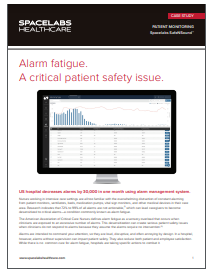Nurses working in intensive care settings are all too familiar with the overwhelming distraction of constant alarming from patient monitors, ventilators, beds, medication pumps, vital sign monitors, and other medical devices in their care area. Research indicates that 72% to 99% of all alarms are not actionable, which can lead caregivers to become desensitized to critical alarms—a condition commonly known as alarm fatigue.
The American Association of Critical Care Nurses defines alarm fatigue as a sensory overload that occurs when clinicians are exposed to an excessive number of alarms. This desensitization can create serious patient safety issues when clinicians do not respond to alarms because they assume the alarms require no intervention.
Alarms are intended to command your attention, so they are loud, disruptive, and often annoying by design. In a hospital, however, alarms without supervision can impact patient safety. They also reduce both patient and employee satisfaction. While there is no common cure for alarm fatigue, hospitals are taking specific actions to combat it.
A hospital in Texas recently implemented Spacelabs SafeNSound™ software to utilize the technology’s alarm management tools, reviewing alarm data reports and making meaningful changes that would not negatively affect patient care. Learn what changes were employed to reduce nuisance alarms per device by 40%, and other significant improvements realized in the first year of implementation.

Request the complete case study
This product is not available for sale in all countries. Please contact your local Spacelabs Healthcare representative or regional office for more information.